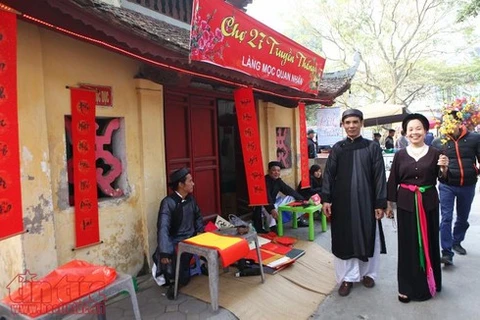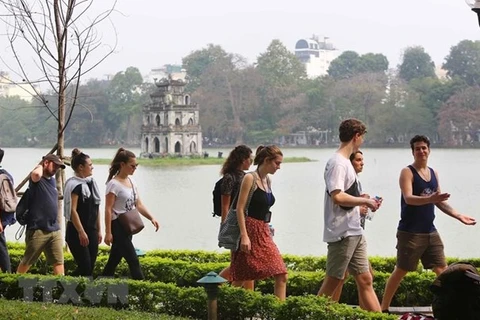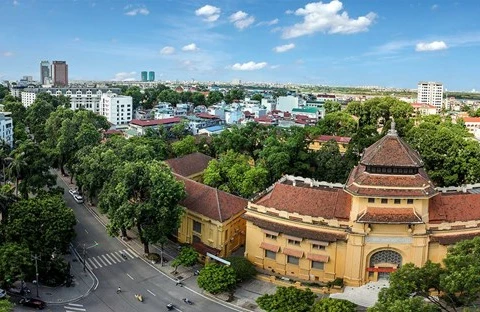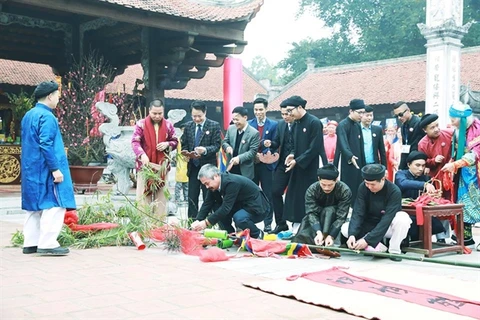 Visiting Hanoi in the early days of winter, visitors cannot help but be surprised to see a very different image of the capital city. Through ups and downs of the history, small street corners with traditional features are always reminiscent of the past, engraved in the hearts of every citizen of the capital. Old street corners full of nostalgia last over years. No matter how bustling and busy streets are, people still feel strangely peaceful when coming there. It could be said that ancient houses and old street corners are always “specialties” that attract tourists whenever they visit the capital city (Photo: VietnamPlus)
Visiting Hanoi in the early days of winter, visitors cannot help but be surprised to see a very different image of the capital city. Through ups and downs of the history, small street corners with traditional features are always reminiscent of the past, engraved in the hearts of every citizen of the capital. Old street corners full of nostalgia last over years. No matter how bustling and busy streets are, people still feel strangely peaceful when coming there. It could be said that ancient houses and old street corners are always “specialties” that attract tourists whenever they visit the capital city (Photo: VietnamPlus)  Wherever they go, those who were born in Hanoi are still proud of the old streets that bring back a lot of fond memories. The capital city is changing day by day with bustling high-rise buildings. However, Hanoi still has tile roofs and yellow walls that are enough for people to be lost in reflection whenever they recall. Houses with old architecture still lie there as if they hold remaining memories of Hanoi through changing years. It is uncertain as to when they have become an inevitable part that people cannot help but miss. In any small street corner, Hanoi still appears peaceful and simple with residents living slowly and leisurely amidst the chaos of life (Photo: VietnamPlus)
Wherever they go, those who were born in Hanoi are still proud of the old streets that bring back a lot of fond memories. The capital city is changing day by day with bustling high-rise buildings. However, Hanoi still has tile roofs and yellow walls that are enough for people to be lost in reflection whenever they recall. Houses with old architecture still lie there as if they hold remaining memories of Hanoi through changing years. It is uncertain as to when they have become an inevitable part that people cannot help but miss. In any small street corner, Hanoi still appears peaceful and simple with residents living slowly and leisurely amidst the chaos of life (Photo: VietnamPlus)  The houses with old painted walls somehow make people feel peaceful and beloved whenever they pass by. In early days of winter in Hanoi, they look beautiful and tranquil. When Hanoi changes day by day, old street corners become busier but their ancient and vaguely sad looks remain, fascinating any passerby. Many houses dating back to the French colonial era still quietly endure the changes of Hanoi. They are the highlight of the neighborhood with red tile roofs, bright yellow walls, and glossy green painted wooden windows. Regretting their ancient beauty before they are replaced by new buildings, many flocked to there to recapture their images (Photo: VietnamPlus)
The houses with old painted walls somehow make people feel peaceful and beloved whenever they pass by. In early days of winter in Hanoi, they look beautiful and tranquil. When Hanoi changes day by day, old street corners become busier but their ancient and vaguely sad looks remain, fascinating any passerby. Many houses dating back to the French colonial era still quietly endure the changes of Hanoi. They are the highlight of the neighborhood with red tile roofs, bright yellow walls, and glossy green painted wooden windows. Regretting their ancient beauty before they are replaced by new buildings, many flocked to there to recapture their images (Photo: VietnamPlus)  The air of oldness and calmness of Hanoi has become a source of inspiration for many photographers, painters and musicians. Ancient places also draw young people to pose for pictures. Old houses of nearly 100 years old with red and blue painted windows and yellow walls are common in the Hanoi Old Quarter. They make a difference to the face of Hanoi neighborhood today. On sunny days, the streets with a long line of age-old houses look to wear yellow. Their timeless mossy walls are only found in Hanoi, becoming strangely beloved. By raising the camera in any place, visitors could save themselves beautiful pictures (Photo: VietnamPlus)
The air of oldness and calmness of Hanoi has become a source of inspiration for many photographers, painters and musicians. Ancient places also draw young people to pose for pictures. Old houses of nearly 100 years old with red and blue painted windows and yellow walls are common in the Hanoi Old Quarter. They make a difference to the face of Hanoi neighborhood today. On sunny days, the streets with a long line of age-old houses look to wear yellow. Their timeless mossy walls are only found in Hanoi, becoming strangely beloved. By raising the camera in any place, visitors could save themselves beautiful pictures (Photo: VietnamPlus)  In Hanoi, there are places that are not for those in a hurry, come and go because their spaces are available for visitors to stand for hours to admire. Whenever mentioning Hanoi, it is impossible not to notice the Old Quarter, which has earned Hanoi the name “A city of 36 streets”. The Hanoi Old Quarter is a valuable heritage of the past and is facing rapid change of life. It is hoped that even with the change, its charm will not disappear in the near future. Its charm partly derives from oriental and French-style architecture, both ancient and modern, that will exist forever over time (Photo: VietnamPlus)
In Hanoi, there are places that are not for those in a hurry, come and go because their spaces are available for visitors to stand for hours to admire. Whenever mentioning Hanoi, it is impossible not to notice the Old Quarter, which has earned Hanoi the name “A city of 36 streets”. The Hanoi Old Quarter is a valuable heritage of the past and is facing rapid change of life. It is hoped that even with the change, its charm will not disappear in the near future. Its charm partly derives from oriental and French-style architecture, both ancient and modern, that will exist forever over time (Photo: VietnamPlus)  Hanoi, a charming city with a history of over one thousand years, is the convergence of cultural and historical essences of Vietnam. Historical documents show that the Hanoi Old Quarter was formed in around the 10th century, and flourished in the 15th -16th centuries. It spans over 82ha to the east of the Thang Long Imperial Citadel, and now spreads over 10 wards of Hoan Kiem district – the heart of Hanoi. Though called “Hanoi – 36 streets”, the Old Quarter in fact has more than 36 streets. It is a common name that has been widely recognised. The Old Quarter has a very unique urban feature, where streets are bustling all the time, but still retains the thousand-year traditional cultural values of the capital land (Photo: VietnamPlus)
Hanoi, a charming city with a history of over one thousand years, is the convergence of cultural and historical essences of Vietnam. Historical documents show that the Hanoi Old Quarter was formed in around the 10th century, and flourished in the 15th -16th centuries. It spans over 82ha to the east of the Thang Long Imperial Citadel, and now spreads over 10 wards of Hoan Kiem district – the heart of Hanoi. Though called “Hanoi – 36 streets”, the Old Quarter in fact has more than 36 streets. It is a common name that has been widely recognised. The Old Quarter has a very unique urban feature, where streets are bustling all the time, but still retains the thousand-year traditional cultural values of the capital land (Photo: VietnamPlus)  The Old Quarter used to be a place where people from all around the Northern Delta gathered and then turned it into the busiest area of the city, with craft and trade activities. Each street housed craftsmen from well-known craft villages and became a miniature village in the heart of Hanoi. Each street is also named after the type of goods or service for sale, starting with the word “Hang” (goods), such as Hang Duong (street of sugar), Hang Bac (street of silver), Hang Mam (street of fish sauce), Hang Ma (street of votive paper), Hang Vai (street of fabric), and more (Photo: VietnamPlus)
The Old Quarter used to be a place where people from all around the Northern Delta gathered and then turned it into the busiest area of the city, with craft and trade activities. Each street housed craftsmen from well-known craft villages and became a miniature village in the heart of Hanoi. Each street is also named after the type of goods or service for sale, starting with the word “Hang” (goods), such as Hang Duong (street of sugar), Hang Bac (street of silver), Hang Mam (street of fish sauce), Hang Ma (street of votive paper), Hang Vai (street of fabric), and more (Photo: VietnamPlus)  Built in the 18th and 19th centuries, houses in this quarter were small, tube-shaped and roofed with thatch leaves or tiles. Most of them have a brick structure with wooden beams or a structure of force-resistant wooden beams with raising pieces supporting the tiles. To make the beams, precious timbers, such as Dinh (Markhamia stipulate), teakwood and ironwood were used. However, what astonished researchers as well as today’s generation is that all calculations for making the house structures were made by workers who had never attended a training course, but only depended on their traditional experiences. In the late 19th and 20th centuries, most houses had a roof made of double tiles or toe cape-shaped tiles (Photo: VietnamPlus)
Built in the 18th and 19th centuries, houses in this quarter were small, tube-shaped and roofed with thatch leaves or tiles. Most of them have a brick structure with wooden beams or a structure of force-resistant wooden beams with raising pieces supporting the tiles. To make the beams, precious timbers, such as Dinh (Markhamia stipulate), teakwood and ironwood were used. However, what astonished researchers as well as today’s generation is that all calculations for making the house structures were made by workers who had never attended a training course, but only depended on their traditional experiences. In the late 19th and 20th centuries, most houses had a roof made of double tiles or toe cape-shaped tiles (Photo: VietnamPlus)  The edges of the roof were decorated with patterns of an old architectural style, creating natural waves. In the 1920s, houses with roofs of the Indochinese style appeared, including sloping tiled roofs and overlapping tiled roofs, which has similar advantages as the Vietnamese traditional ones. Many visitors visiting the Old Quarter will feel like returning to the past because of the small space and unique architecture, which is completely different from the crowded streets adjacent to tall buildings or modern works. It is hoped that even with the change, its charm will not disappear in the near future. Its charm partly derives from oriental and French-style architecture, both ancient and modern, that will exist forever through the time (Photo: VietnamPlus)
The edges of the roof were decorated with patterns of an old architectural style, creating natural waves. In the 1920s, houses with roofs of the Indochinese style appeared, including sloping tiled roofs and overlapping tiled roofs, which has similar advantages as the Vietnamese traditional ones. Many visitors visiting the Old Quarter will feel like returning to the past because of the small space and unique architecture, which is completely different from the crowded streets adjacent to tall buildings or modern works. It is hoped that even with the change, its charm will not disappear in the near future. Its charm partly derives from oriental and French-style architecture, both ancient and modern, that will exist forever through the time (Photo: VietnamPlus)  First-time visitors, or foreign tourists, may feel overwhelmed, confused when walking on the crowded, narrow streets with houses sitting close together and vehicles criss-crossing. The scene is probably a bit chaotic for strangers. But in order to see the special culture and life there, they need to go and feel with their own eyes. With its time-tested beauty, the Hanoi Old Quarter has become a major theme in numerous paintings by well-known artist Bui Xuan Phai (1920-1988). Now, whenever mentioning Bui Xuan Phai, people think of the Hanoi Old Quarter, and when it comes to the Hanoi Old Quarter, the name "Pho Phai" (Phai Street) is not strange (Photo: VietnamPlus)
First-time visitors, or foreign tourists, may feel overwhelmed, confused when walking on the crowded, narrow streets with houses sitting close together and vehicles criss-crossing. The scene is probably a bit chaotic for strangers. But in order to see the special culture and life there, they need to go and feel with their own eyes. With its time-tested beauty, the Hanoi Old Quarter has become a major theme in numerous paintings by well-known artist Bui Xuan Phai (1920-1988). Now, whenever mentioning Bui Xuan Phai, people think of the Hanoi Old Quarter, and when it comes to the Hanoi Old Quarter, the name "Pho Phai" (Phai Street) is not strange (Photo: VietnamPlus)  Phai once showed his feeling about the streets in his diary: “Hanoi has many beauties, old and new, but each beauty is suitable to each person. Old streets and houses with deep brown tile roof, walls covered with moss lying quietly will easily appear beautiful on paintings. Their rhythm is not as even as high-rise buildings and prefabricated houses”. Hanoi’s beauty is not only shown in the Old Quarter, but also a blend of western and oriental architecture, notably works built in the late 19th and early 20th centuries such as buildings in the classical French style, luxury villas owned by French officials or wealthy Vietnamese working for foreigners (Photo: VietnamPlus)
Phai once showed his feeling about the streets in his diary: “Hanoi has many beauties, old and new, but each beauty is suitable to each person. Old streets and houses with deep brown tile roof, walls covered with moss lying quietly will easily appear beautiful on paintings. Their rhythm is not as even as high-rise buildings and prefabricated houses”. Hanoi’s beauty is not only shown in the Old Quarter, but also a blend of western and oriental architecture, notably works built in the late 19th and early 20th centuries such as buildings in the classical French style, luxury villas owned by French officials or wealthy Vietnamese working for foreigners (Photo: VietnamPlus)  Up to 1,586 French-style buildings and villas, built over 100 years ago, are conserved at present. As many as 562 of them are used by individuals and the remaining owned by the State. In 2019, Hanoi won the Travelers’ Choice Awards and was ranked among the 25 leading destinations in Asia, and the world’s 25 leading places on TripAdvisor website. CNN listed Hanoi along with Phu Quoc Island in the Mekong Delta province of Kien Giang as the best travel destinations in Asia in 2019. Many highlights of Hanoi were listed in CNN’s article suggesting 13 memorable experiences for foreign visitors in Vietnam (Photo: VietnamPlus)
Up to 1,586 French-style buildings and villas, built over 100 years ago, are conserved at present. As many as 562 of them are used by individuals and the remaining owned by the State. In 2019, Hanoi won the Travelers’ Choice Awards and was ranked among the 25 leading destinations in Asia, and the world’s 25 leading places on TripAdvisor website. CNN listed Hanoi along with Phu Quoc Island in the Mekong Delta province of Kien Giang as the best travel destinations in Asia in 2019. Many highlights of Hanoi were listed in CNN’s article suggesting 13 memorable experiences for foreign visitors in Vietnam (Photo: VietnamPlus)  The city has coordinated with CNN to promote its image through short advertising clips such as “Hanoi - The Cradle of Heritage” and “Hanoi - The Heart of Vietnam”, which have attracted a lot of foreign viewers. After completing the deal for 2018-2019, the capital city signed another contract with CNN for 2019-2024. In 2019, Hanoi was also ranked fifth among the seven best places in Asia for solo travellers by Bigseventravel. The Italian tourism website described Hanoi as a hectic, crazy and often confusing city, and a wonderful base from which to explore the north of Vietnam, including the world natural heritage site of Ha Long Bay in the northeastern province of Quang Ninh and the popular resort town of Sa Pa in the northern mountainous province of Lao Cai (Photo: VietnamPlus)
The city has coordinated with CNN to promote its image through short advertising clips such as “Hanoi - The Cradle of Heritage” and “Hanoi - The Heart of Vietnam”, which have attracted a lot of foreign viewers. After completing the deal for 2018-2019, the capital city signed another contract with CNN for 2019-2024. In 2019, Hanoi was also ranked fifth among the seven best places in Asia for solo travellers by Bigseventravel. The Italian tourism website described Hanoi as a hectic, crazy and often confusing city, and a wonderful base from which to explore the north of Vietnam, including the world natural heritage site of Ha Long Bay in the northeastern province of Quang Ninh and the popular resort town of Sa Pa in the northern mountainous province of Lao Cai (Photo: VietnamPlus)  The capital is changing day by day with bustling high-rise buildings. However, Hanoi still has tile roofs and yellow walls that are enough for people to be lost in reflection whenever they recall. According to the 2021 TripAdvisor Travelers’ Choice Awards, the city was one of the four Vietnamese cities listed among the most popular destinations in Asia in 2020. On the list, the capital city of Hanoi ranked second, the ancient city of Hoi An in central Quang Nam province came fourth, Ho Chi Minh City was placed 11th, and central Da Nang city was at the 16th position. The capital city was also ranked the sixth place among the 25 most popular destinations in the world by TripAdvisor (Photo: VietnamPlus)
The capital is changing day by day with bustling high-rise buildings. However, Hanoi still has tile roofs and yellow walls that are enough for people to be lost in reflection whenever they recall. According to the 2021 TripAdvisor Travelers’ Choice Awards, the city was one of the four Vietnamese cities listed among the most popular destinations in Asia in 2020. On the list, the capital city of Hanoi ranked second, the ancient city of Hoi An in central Quang Nam province came fourth, Ho Chi Minh City was placed 11th, and central Da Nang city was at the 16th position. The capital city was also ranked the sixth place among the 25 most popular destinations in the world by TripAdvisor (Photo: VietnamPlus)  Hanoi has set itself a target to greet 35-39 million tourists by 2025, including 8-9 million foreigners, earning about 151 trillion VND (6.53 billion USD), under the city’s recently-launched tourism development strategy with a vision to 2030. The capital city hopes to welcome 48-49 million visitors by 2030, 13-14 million of them foreigners. Hanoi will work to turn tourism into a spearhead economic sector which also serves as a driving force for others. It will apply cutting-edge technology and take skilled human resources a breakthrough factor for tourism development. To realise the targets, local authorities will bolster tourism infrastructure investment and resources which will be carried out in a concerted and harmonious manner (Photo: VietnamPlus)
Hanoi has set itself a target to greet 35-39 million tourists by 2025, including 8-9 million foreigners, earning about 151 trillion VND (6.53 billion USD), under the city’s recently-launched tourism development strategy with a vision to 2030. The capital city hopes to welcome 48-49 million visitors by 2030, 13-14 million of them foreigners. Hanoi will work to turn tourism into a spearhead economic sector which also serves as a driving force for others. It will apply cutting-edge technology and take skilled human resources a breakthrough factor for tourism development. To realise the targets, local authorities will bolster tourism infrastructure investment and resources which will be carried out in a concerted and harmonious manner (Photo: VietnamPlus)  Pronounced the capital of Vietnam in 1010, Hanoi is one of the most ancient cities in Asia, offering great examples of both contemporary and classical architecture right in the city centre. The city is famous for its vivid yellow colonial villas and an enchanting busy life in the Old Quarter Area. Lakes, parks, green boulevards, and more than 600 temples and pagodas also add to the appeal of Hanoi, according to the Time newspaper. The iconic Hoan Kiem Lake is a beautiful enchanting body of water right in the heart of the capital. Next to the lake is the Old Quarter Area - a highlight for most visitors to Hanoi (Photo: VietnamPlus)
Pronounced the capital of Vietnam in 1010, Hanoi is one of the most ancient cities in Asia, offering great examples of both contemporary and classical architecture right in the city centre. The city is famous for its vivid yellow colonial villas and an enchanting busy life in the Old Quarter Area. Lakes, parks, green boulevards, and more than 600 temples and pagodas also add to the appeal of Hanoi, according to the Time newspaper. The iconic Hoan Kiem Lake is a beautiful enchanting body of water right in the heart of the capital. Next to the lake is the Old Quarter Area - a highlight for most visitors to Hanoi (Photo: VietnamPlus)  Hanoi ranked 15th in the list of 25 most popular destinations of the 2020 Tripadvisor Travellers’ Choice Awards. According to the famous American travel website, the charming Vietnamese capital has aged well, preserving the Old Quarter, monuments and colonial architecture, while making room for modern developments alongside. Lakes, parks, shady boulevards and more than 600 temples and pagodas add to the appeal of this city, which is easily explored by taxi. Up to 1,586 French-style buildings and villas, built over 100 years ago, are conserved at present in Hanoi. As many as 562 of them are used by individuals and the remaining owned by the State (Photo: VietnamPlus)
Hanoi ranked 15th in the list of 25 most popular destinations of the 2020 Tripadvisor Travellers’ Choice Awards. According to the famous American travel website, the charming Vietnamese capital has aged well, preserving the Old Quarter, monuments and colonial architecture, while making room for modern developments alongside. Lakes, parks, shady boulevards and more than 600 temples and pagodas add to the appeal of this city, which is easily explored by taxi. Up to 1,586 French-style buildings and villas, built over 100 years ago, are conserved at present in Hanoi. As many as 562 of them are used by individuals and the remaining owned by the State (Photo: VietnamPlus)  When Hanoi changes day by day, old street corners become busier but their ancient and vaguely sad looks remain, fascinating any passerby. Many houses dating back to the French colonial era still quietly endure the changes of Hanoi. They are the highlight of the neighborhood with red tile roofs, bright yellow walls, and glossy green painted wooden windows. With its time-tested beauty, the Hanoi Old Quarter has become a major theme in numerous paintings by well-known artist Bui Xuan Phai (1920-1988). Now, whenever mentioning Bui Xuan Phai, people think of the Hanoi Old Quarter, and when it comes to the Hanoi Old Quarter, the name "Pho Phai" (Phai Street) is not strange (Photo: VietnamPlus)
When Hanoi changes day by day, old street corners become busier but their ancient and vaguely sad looks remain, fascinating any passerby. Many houses dating back to the French colonial era still quietly endure the changes of Hanoi. They are the highlight of the neighborhood with red tile roofs, bright yellow walls, and glossy green painted wooden windows. With its time-tested beauty, the Hanoi Old Quarter has become a major theme in numerous paintings by well-known artist Bui Xuan Phai (1920-1988). Now, whenever mentioning Bui Xuan Phai, people think of the Hanoi Old Quarter, and when it comes to the Hanoi Old Quarter, the name "Pho Phai" (Phai Street) is not strange (Photo: VietnamPlus)  In 2019, Hanoi was also ranked fifth among the seven best places in Asia for solo travellers by Bigseventravel. The Italian tourism website described Hanoi as a hectic, crazy and often confusing city, and a wonderful base from which to explore the north of Vietnam, including the world natural heritage site of Ha Long Bay in the northeastern province of Quang Ninh and the popular resort town of Sa Pa in the northern mountainous province of Lao Cai. Hanoi has set itself a target to greet 35-39 million tourists by 2025, including 8-9 million foreigners, earning about 151 trillion VND (6.53 billion USD) (Photo: VietnamPlus)
In 2019, Hanoi was also ranked fifth among the seven best places in Asia for solo travellers by Bigseventravel. The Italian tourism website described Hanoi as a hectic, crazy and often confusing city, and a wonderful base from which to explore the north of Vietnam, including the world natural heritage site of Ha Long Bay in the northeastern province of Quang Ninh and the popular resort town of Sa Pa in the northern mountainous province of Lao Cai. Hanoi has set itself a target to greet 35-39 million tourists by 2025, including 8-9 million foreigners, earning about 151 trillion VND (6.53 billion USD) (Photo: VietnamPlus)  Through ups and downs of the history, the small street corners with traditional features are always reminiscent of the past, engraved in the hearts of every citizen of the capital. Old street corners full of nostalgia last over years. No matter how bustling and busy streets are, people still feel strangely peaceful when coming there. First-time visitors, or foreign tourists, may feel overwhelmed, confused when walking on the crowded, narrow streets with houses sitting close together and vehicles crisscrossing. The scene is probably a bit chaotic for strangers. But in order to see the special culture and life there, they need to go and feel with their own eyes (Photo: VietnamPlus)
Through ups and downs of the history, the small street corners with traditional features are always reminiscent of the past, engraved in the hearts of every citizen of the capital. Old street corners full of nostalgia last over years. No matter how bustling and busy streets are, people still feel strangely peaceful when coming there. First-time visitors, or foreign tourists, may feel overwhelmed, confused when walking on the crowded, narrow streets with houses sitting close together and vehicles crisscrossing. The scene is probably a bit chaotic for strangers. But in order to see the special culture and life there, they need to go and feel with their own eyes (Photo: VietnamPlus)  In the 1920s, houses with roofs of the Indochinese style appeared, including sloping tiled roofs and overlapping tiled roofs, which has similar advantages as the Vietnamese traditional ones. Many visitors visiting the Old Quarter will feel like returning to the past because of the small space and unique architecture, which is completely different from the crowded streets adjacent to tall buildings or modern works. The air of oldness and calmness of Hanoi has become a source of inspiration for many photographers, painters and musicians. Ancient places also draw young people to pose for pictures. Worn-out houses of nearly 100 years old with red and blue painted windows and yellow walls are common in the Hanoi Old Quarter (Photo: VietnamPlus)
In the 1920s, houses with roofs of the Indochinese style appeared, including sloping tiled roofs and overlapping tiled roofs, which has similar advantages as the Vietnamese traditional ones. Many visitors visiting the Old Quarter will feel like returning to the past because of the small space and unique architecture, which is completely different from the crowded streets adjacent to tall buildings or modern works. The air of oldness and calmness of Hanoi has become a source of inspiration for many photographers, painters and musicians. Ancient places also draw young people to pose for pictures. Worn-out houses of nearly 100 years old with red and blue painted windows and yellow walls are common in the Hanoi Old Quarter (Photo: VietnamPlus)  Many houses dating back to the French colonial era still quietly endure the changes of Hanoi. They are the highlight of the neighborhood with red tile roofs, bright yellow walls, and glossy green painted wooden windows. With its time-tested beauty, the Hanoi Old Quarter has become a major theme in numerous paintings by well-known artist Bui Xuan Phai (1920-1988). Phai once wrote his feeling about the streets in his diary: “Hanoi has many beauties, old and new, but each beauty is suitable to each person. Old streets and houses with deep brown tile roof, walls covered with moss lying quietly will easily appear beautiful on paintings. Their rhythm is not as even as high-rise buildings and prefabricated houses” (Photo: VietnamPlus)
Many houses dating back to the French colonial era still quietly endure the changes of Hanoi. They are the highlight of the neighborhood with red tile roofs, bright yellow walls, and glossy green painted wooden windows. With its time-tested beauty, the Hanoi Old Quarter has become a major theme in numerous paintings by well-known artist Bui Xuan Phai (1920-1988). Phai once wrote his feeling about the streets in his diary: “Hanoi has many beauties, old and new, but each beauty is suitable to each person. Old streets and houses with deep brown tile roof, walls covered with moss lying quietly will easily appear beautiful on paintings. Their rhythm is not as even as high-rise buildings and prefabricated houses” (Photo: VietnamPlus)  Hanoi’s beauty is not only shown in the Old Quarter, but also a blend of western and oriental architecture, notably works built in the late 19th and early 20th centuries such as buildings in the classical French style, luxury villas owned by French officials or wealthy Vietnamese working for foreigners. Up to 1,586 French-style buildings and villas, built over 100 years ago, are conserved at present. As many as 562 of them are used by individuals and the remaining owned by the State. Through ups and downs of the history, the small street corners with traditional features are always reminiscent of the past, engraved in the hearts of every citizen of the capital. Old street corners full of nostalgia last over years (Photo: VietnamPlus)
Hanoi’s beauty is not only shown in the Old Quarter, but also a blend of western and oriental architecture, notably works built in the late 19th and early 20th centuries such as buildings in the classical French style, luxury villas owned by French officials or wealthy Vietnamese working for foreigners. Up to 1,586 French-style buildings and villas, built over 100 years ago, are conserved at present. As many as 562 of them are used by individuals and the remaining owned by the State. Through ups and downs of the history, the small street corners with traditional features are always reminiscent of the past, engraved in the hearts of every citizen of the capital. Old street corners full of nostalgia last over years (Photo: VietnamPlus)  When Hanoi changes day by day, old street corners become busier but their ancient and vaguely sad looks remain, fascinating any passerby. The capital is changing day by day with bustling high-rise buildings. However, Hanoi still has tile roofs and yellow walls that are enough for people to be lost in reflection whenever they recall. In the 1920s, houses with roofs of the Indochinese style appeared, including sloping tiled roofs and overlapping tiled roofs, which has similar advantages as the Vietnamese traditional ones. Many visitors visiting the Old Quarter will feel like returning to the past because of the small space and unique architecture, which is completely different from the crowded streets adjacent to tall buildings or modern works (Photo: VietnamPlus)
When Hanoi changes day by day, old street corners become busier but their ancient and vaguely sad looks remain, fascinating any passerby. The capital is changing day by day with bustling high-rise buildings. However, Hanoi still has tile roofs and yellow walls that are enough for people to be lost in reflection whenever they recall. In the 1920s, houses with roofs of the Indochinese style appeared, including sloping tiled roofs and overlapping tiled roofs, which has similar advantages as the Vietnamese traditional ones. Many visitors visiting the Old Quarter will feel like returning to the past because of the small space and unique architecture, which is completely different from the crowded streets adjacent to tall buildings or modern works (Photo: VietnamPlus)  Historical documents show that the Hanoi Old Quarter was formed in around the 10th century, and flourished in the 15th -16th centuries. Though called “Hanoi – 36 streets”, the Old Quarter in fact has more than 36 streets. Each street housed craftsmen from well-known craft villages and became a miniature village in the heart of Hanoi. Each street is also named after the type of goods or service for sale, starting with the word “Hang” (goods), such as Hang Duong (street of sugar), Hang Bac (street of silver), Hang Mam (street of fish sauce), Hang Ma (street of votive paper), Hang Vai (street of fabric), and more (Photo: VietnamPlus)
Historical documents show that the Hanoi Old Quarter was formed in around the 10th century, and flourished in the 15th -16th centuries. Though called “Hanoi – 36 streets”, the Old Quarter in fact has more than 36 streets. Each street housed craftsmen from well-known craft villages and became a miniature village in the heart of Hanoi. Each street is also named after the type of goods or service for sale, starting with the word “Hang” (goods), such as Hang Duong (street of sugar), Hang Bac (street of silver), Hang Mam (street of fish sauce), Hang Ma (street of votive paper), Hang Vai (street of fabric), and more (Photo: VietnamPlus)  Many visitors visiting the Old Quarter will feel like returning to the past because of the small space and unique architecture, which is completely different from the crowded streets adjacent to tall buildings or modern works. It is hoped that even with the change, its charm will not disappear in the near future. Its charm partly derives from oriental and French-style architecture, both ancient and modern, that will exist forever over time. The city has coordinated with CNN to promote its image through short advertising clips such as “Hanoi-Cradle of Heritage” and “Hanoi-Heart of Vietnam”, which have attracted a lot of foreign viewers (Photo: VietnamPlus)
Many visitors visiting the Old Quarter will feel like returning to the past because of the small space and unique architecture, which is completely different from the crowded streets adjacent to tall buildings or modern works. It is hoped that even with the change, its charm will not disappear in the near future. Its charm partly derives from oriental and French-style architecture, both ancient and modern, that will exist forever over time. The city has coordinated with CNN to promote its image through short advertising clips such as “Hanoi-Cradle of Heritage” and “Hanoi-Heart of Vietnam”, which have attracted a lot of foreign viewers (Photo: VietnamPlus)  According to the famous American travel website, the charming Vietnamese capital has aged well, preserving the Old Quarter, monuments and colonial architecture, while making room for modern developments alongside. Lakes, parks, shady boulevards and more than 600 temples and pagodas add to the appeal of this city, which is easily explored by taxi. Up to 1,586 French-style buildings and villas, built over 100 years ago, are conserved at present in Hanoi. Hanoi has set itself a target to greet 35-39 million tourists by 2025, including 8-9 million foreigners, earning about 151 trillion VND (6.53 billion USD), under the city’s recently-launched tourism development strategy with a view to 2030 (Photo: VietnamPlus)
According to the famous American travel website, the charming Vietnamese capital has aged well, preserving the Old Quarter, monuments and colonial architecture, while making room for modern developments alongside. Lakes, parks, shady boulevards and more than 600 temples and pagodas add to the appeal of this city, which is easily explored by taxi. Up to 1,586 French-style buildings and villas, built over 100 years ago, are conserved at present in Hanoi. Hanoi has set itself a target to greet 35-39 million tourists by 2025, including 8-9 million foreigners, earning about 151 trillion VND (6.53 billion USD), under the city’s recently-launched tourism development strategy with a view to 2030 (Photo: VietnamPlus)  Houses with old architecture still lie there as if they hold remaining memories of Hanoi through changing years. It is uncertain as to when they have become an inevitable part that people cannot help but miss. In any small street corner, Hanoi still appears peaceful and simple with residents living slowly and leisurely amidst the chaos of life. Hanoi’s beauty is not only shown in the Old Quarter, but also a blend of western and oriental architecture, notably works built in the late 19th and early 20th centuries such as buildings in the classical French style, luxury villas owned by French officials or wealthy Vietnamese working for foreigners (Photo: VietnamPlus)
Houses with old architecture still lie there as if they hold remaining memories of Hanoi through changing years. It is uncertain as to when they have become an inevitable part that people cannot help but miss. In any small street corner, Hanoi still appears peaceful and simple with residents living slowly and leisurely amidst the chaos of life. Hanoi’s beauty is not only shown in the Old Quarter, but also a blend of western and oriental architecture, notably works built in the late 19th and early 20th centuries such as buildings in the classical French style, luxury villas owned by French officials or wealthy Vietnamese working for foreigners (Photo: VietnamPlus)  In the late 19th and 20th centuries, most houses had a roof made of double tiles or toe cape-shaped tiles. Built in the 18th and 19th centuries, houses in this quarter were small, tube-shaped and roofed with thatch leaves or tiles. Most of them have a brick structure with wooden beams or a structure of force-resistant wooden beams with raising pieces supporting the tiles. To make the beams, precious timbers, such as Dinh (Markhamia stipulate), teakwood and ironwood were used. However, what astonished researchers as well as today’s generation is that all calculations for making the house structures were made by workers who had never attended a training course, but only depended on their traditional experience (Photo: VietnamPlus)
In the late 19th and 20th centuries, most houses had a roof made of double tiles or toe cape-shaped tiles. Built in the 18th and 19th centuries, houses in this quarter were small, tube-shaped and roofed with thatch leaves or tiles. Most of them have a brick structure with wooden beams or a structure of force-resistant wooden beams with raising pieces supporting the tiles. To make the beams, precious timbers, such as Dinh (Markhamia stipulate), teakwood and ironwood were used. However, what astonished researchers as well as today’s generation is that all calculations for making the house structures were made by workers who had never attended a training course, but only depended on their traditional experience (Photo: VietnamPlus)  According to the 2021 TripAdvisor Travelers’ Choice Awards, the city was one of the four Vietnamese cities listed among the most popular destinations in Asia in 2020. On the list, Hanoi ranked second, ancient town Hoi An in central Quang Nam province fourth, Ho Chi Minh City 11th, and central Da Nang city 16th. The capital city was also ranked the sixth place among the 25 most popular destinations in the world by Tripadvisor. The Italian tourism website described Hanoi as a hectic, crazy and often confusing city, and a wonderful base from which to explore the north of Vietnam. In 2019, Hanoi was also ranked fifth among the seven best places in Asia for solo travellers by Bigseventravel (Photo: VietnamPlus)
According to the 2021 TripAdvisor Travelers’ Choice Awards, the city was one of the four Vietnamese cities listed among the most popular destinations in Asia in 2020. On the list, Hanoi ranked second, ancient town Hoi An in central Quang Nam province fourth, Ho Chi Minh City 11th, and central Da Nang city 16th. The capital city was also ranked the sixth place among the 25 most popular destinations in the world by Tripadvisor. The Italian tourism website described Hanoi as a hectic, crazy and often confusing city, and a wonderful base from which to explore the north of Vietnam. In 2019, Hanoi was also ranked fifth among the seven best places in Asia for solo travellers by Bigseventravel (Photo: VietnamPlus)  It could be said that ancient houses and old street corners are always “specialty” that attracts tourists whenever they visit the capital. Hanoi, a charming city with a history of over one thousand years, is the convergence of cultural and historical essences of Vietnam. Visiting Hanoi in the early days of winter, visitors cannot help but be surprised to see a very different image of the capital. Many visitors visiting the Old Quarter will feel like returning to the past because of the small space and unique architecture, which is completely different from the crowded streets adjacent to tall buildings or modern works (Photo: VietnamPlus)
It could be said that ancient houses and old street corners are always “specialty” that attracts tourists whenever they visit the capital. Hanoi, a charming city with a history of over one thousand years, is the convergence of cultural and historical essences of Vietnam. Visiting Hanoi in the early days of winter, visitors cannot help but be surprised to see a very different image of the capital. Many visitors visiting the Old Quarter will feel like returning to the past because of the small space and unique architecture, which is completely different from the crowded streets adjacent to tall buildings or modern works (Photo: VietnamPlus) VNA























